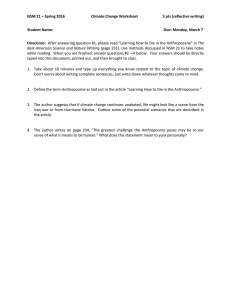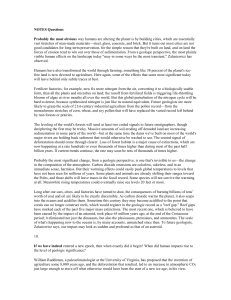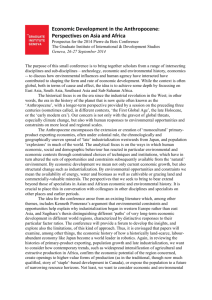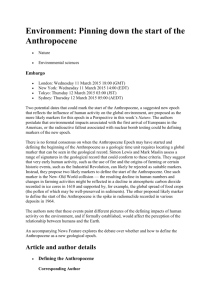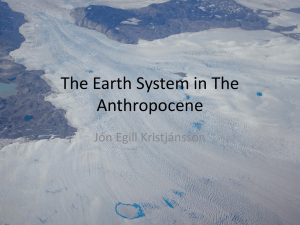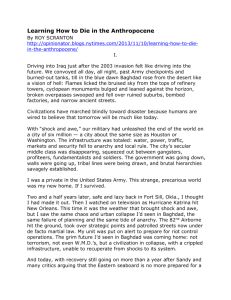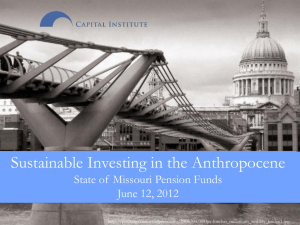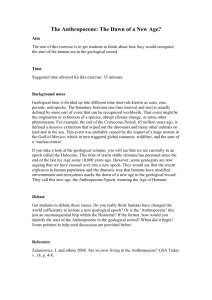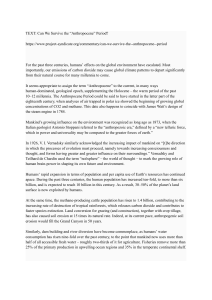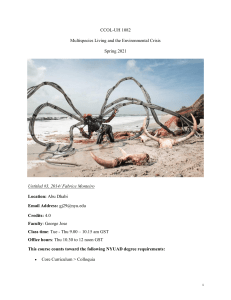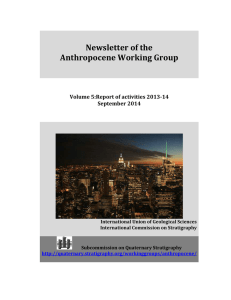The Anthropocene Epoch
advertisement
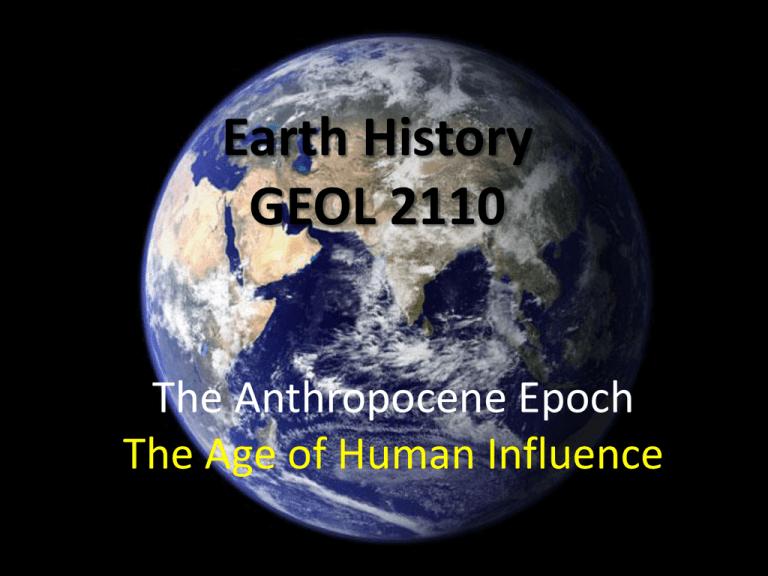
Earth History GEOL 2110 The Anthropocene Epoch The Age of Human Influence Entomology May 2011 The name Anthropocene is a combination of Greek roots: anthropos (Greek: ἄνθρωπος) meaning "human" and cene meaning "new". All epochs in the Cenozoic Era end in "-cene". PEOMPP – HA! Proposal for the Anthropocene Epoch Term was first used in print in 2000 by Paul Crutzen, a Nobel Prizewinning atmospheric chemist, and Eugene Stoermer in a newsletter of the International GeosphereBiosphere Programme. Paul Crutzen 1933 - Proposed the term to reflect the influence of human behavior on the Earth's atmosphere, biosphere, and lithosphere Appeal for Official Designation to the International Commission on Stratigraphic Nomenclature The 'Anthropocene' is currently not a formally defined geological unit within the Geological Time Scale. A proposal to formalize the term is being developed by the Anthropocene Working Group for consideration by the International Commission on Stratigraphy, with a current target date of 2016. To be accepted as a formal term the 'Anthropocene' needs to be A) scientifically justified (i.e. the 'geological signal' currently being produced in strata now forming must be sufficiently large, clear and distinctive) and B) useful as a formal term to the scientific community. When Did the Anthropocene Begin? When Did the Anthropocene Begin? Beginning of Agriculture ~8,000 years ago • • • the development of farming and animal husbandry ancient farmers cleared forests to grow crops – impact to carbon cycle balance Some scientists argue that 8,000 years ago Earth sustained a few million people and was still fundamentally pristine Humans commandeer 75% of the global land surface outside of the Greenland and Antarctic ice sheets, and we’re bringing more wild land under our control every day When did the Anthropocene Begin? Land use 8,000 years ago When did the Anthropocene Begin? When Did the Anthropocene Begin? Empires and Kingdoms ~2,000 years ago Roman Empire - Europe, the Middle East and North Africa. China – the classical dynasties were flowering India - largest economy of the ancient and medieval world Vast kingdoms in Sudan and Ethiopia, central Mexico and Guatemala, and northern Peru When Did the Anthropocene Begin? Industrial Revolution~ 1800 AD The Industrial Revolution caused huge problems as well as benefits. It paved the way for the prosperity much of the Western world takes for granted today. Yet burning coal polluted the air in cities causing health problems; inadequate sanitation and refuse collection created horrifying outbreaks of disease; factory workers were poisoned by hazardous materials. Only recently have humans attempted to mitigate the detrimental impacts of unrestrained industrialization. When Did the Anthropocene Begin? The Dawn of the Atomic Age (1947) and the Great Acceleration We’ve been changing the world around us for millennia. But the scale and speed of change in the last 60 years have been incredible, leading scientists to call events since the 1950s the ‘Great Acceleration’, Our increasing demand for natural resources and polluting habits are ratcheting up the pressure on ecosystems all over the world. At the dawn of the nineteenth century, the world’s population was 1 billion; it’s now seven times that, and by 2050 it’s predicted to pass 9 billion. Over the past 60 years, we have been catching more fish, cutting down more forests, emitting more nitrogen pollution, bringing more land under cultivation and driving more species into extinction than ever before. When did the Anthropocene Begin? Nature of Human Effects Nature of Human Effects Urbanization Nature of Human Effects Damning of Rivers • Blocks spawning fish • Build-up of organics creates oxygenstarved dead zones • Interferes with conveyance of sediment, logs, and other material important to the river ecosystem Over 1000 dams in the US have been removed over the past 50 years. Nature of Human Effects Landfills Rubbish dumped on the tundra outside llulissat in Greenland Nature of Human Effects Diminshed Biodiversity The International Union for the Conservation of Nature calculated in 2004 that the rate of extinction had reached 100-1,000 times that suggested by the fossil records before humans – a situation comparable to the five previous "mass extinctions“ The number of wild animals on Earth has halved in the past 40 years, according to a 2014 analysis by the WWF. Creatures across land, rivers and the seas are being decimated as humans kill them for food in unsustainable numbers, while at the same time polluting or destroying their habitats The fastest decline among the animal populations were found in freshwater ecosystems, where numbers have plummeted by 75% since 1970. Nature of Human Effects Destruction of Coral Reefs Coral reefs are dying around the world. In particular, coral mining, pollution (organic and non-organic), overfishing, blast fishing and the digging of canals and access into islands and bays are serious threats to these ecosystems. Coral reefs also face high dangers from diseases, destructive fishing practices and warming oceans. Nature of Human Effects Geomorphology Increases in erosion due to farming and other operations are reflected by changes in sediment composition and increases in deposition rates elsewhere Through mining activities alone, humans move more sediment than all the world's rivers combined. Nature of Human Effects Agriculture 52% 7% Nature of Human Effects Nitrogen – the New Iridium Agricultural and industrial nitrogen (N) inputs to the environment currently exceed inputs from natural N fixation. As a consequence of anthropogenic inputs, the global nitrogen cycle (Fig. 1) has been significantly altered over the past century. Global atmospheric nitrous oxide (N2O) mole fractions have increased from a pre-industrial value of ~270 nmol/mol to ~319 nmol/mol in 2005 Nature of Human Effects Climate Change Nature of Human Effects Local Climate Change Warming of Lake Superior Austin and Colman (2008) What to Do? A brief history of the UN climate talks June 1992 At the Rio Earth Summit, countries agree to establish the UN Framework Convention on Climate Change. December 1997 The first international agreement to cut carbon emissions, the Kyoto protocol, is finalized. February 2005 The Kyoto Protocol becomes international law after Russia ratifies the agreement. The US fails to ratify it. December 2009 A summit in Copenhagen (COP15) ends in disappointment with a weak deal on action after Kyoto expires in 2012, leading countries to submit voluntary carbon cuts up to 2020. December, 2011 Leaders in Durban (COP17) agree that by 2015 they will finalize an agreement on emissions cuts beyond 2020. November 2014 China and US strike deal hailed as historic by observers, with US pledging to cut emissions by at least 26% by 2025 and China to peak emissions by 2030. December 2014 In Lima (COP21), negotiators agree a draft text for a climate deal to be finalised in Paris in 2015, which will mandate cuts from all the nearly 200 countries in the UN process. February and March 2015 Switzerland becomes the first country to announce its pledge for the Paris climate summit (an ‘INDC’ in UN jargon), followed by the EU as a bloc. Other countries are expected to follow. What to Do? Next Lecture Sustainability of Earth Resources Precambrian Field Trip Overview Precambrian Field Trip Sunday, May 3, 2015 DEPART at 7:30AM Overview on Friday, May 1
